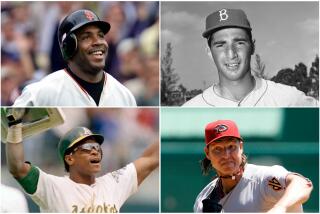Baseball Economics Thinning Ranks of Older Players
- Share via
SCOTTSDALE, Ariz. — The graying of baseball has slowed noticeably under the revised economics of the national pastime.
Just a few years ago it appeared graybeard ballplayers would be a permanent fixture in the major leagues in the 1980s due to the advances in sports medicine and surgery.
But that was before the belt-tightening by baseball executives. The logic is simple: why pay a 42-year old player a big salary when the money would be better spent on a young prospect?
There are still members of the “over 40” gang making a go of it this spring, including Don Sutton with California; Tommy John with the New York Yankees; Phil Niekro with Cleveland, and Steve Carlton with Philadelphia again. Others like Tom Seaver and Graig Nettles are waiting for an offer that might not come.
Training camps in Arizona and Florida probably will see fewer older players fighting for jobs unless they are willing to take drastic salary cuts. Even if they are, they will find management eyeing younger, inexpensive ballplayers more closely.
“We have been committed to investing in youth,” says Cubs President-General Manager Dallas Green. “I don’t know if it’s a trend but we made the commitment to build up the farm system with our resources. It doesn’t make a lot of sense to commit funds to a player who may only help you for a year or two when someone else might be around for 10 or 15 years.”
John, attempting to latch on with the Yanks again at 44, admits he is trying to prolong his career for reasons besides money.
“The deal I have with George (Yankee owner Steinbrenner) is structured to put the incentive on me making the team,” says John, who retired last year only to return to the majors after an aborted coaching career in North Carolina. “I wouldn’t be going through the rigors of staying in shape and trying to make a major league ballclub unless baseball was still fun for me.”
The change in attitude toward the older players may have begun at the same time the owners decided high salaried free agents could be poor risks.
During the winter, players like Seaver of the Red Sox, Nettles of the Padres, Carlton of the Phils, Giants and White Sox and even Pete Rose of the Reds found themselves off clubs’ 40-man rosters. Just two years ago, a national publication heralded these players as candidates to play up until at least 1990.
“I know the players are saying it’s collusion but it isn’t. If we are to survive, as owners, we can’t keep paying that kind of salaries to ballplayers, regardless of their ages,” says Eddie Einhorn, president of the Chicago White Sox. “Some have said some of the older players have a certain draw to bring in people to the park. We had some games when Tom Seaver pitched and the crowds were no bigger than when a rookie pitched.”
Niekro may be an exception. At age 47, he remains a wunderkind, fluttering his knuckleball past baffled hitters for the Indians. But even he realizes that he is now on a contending club that requires him to produce or else.
“We’ve got a chance to win it all in Cleveland this year. I want to be a part of it,” says Niekro, who has never pitched in a World Series in his quarter of a century in baseball. “It’s important to me.”
Seaver can probably afford to wait to see if the trend continues.
“I’m in a position where if I play, the situation will be right,” said the 311-game winner. “If I don’t play, that’s also acceptable. There are pluses on both sides . . . I’d like to rent a VW bus and tour the wine districts in France.”
Oakland seems to be the exception in terms of gambling on older players.
The A’s, also contenders for a divisional crown, have 39-year-old Ron Cey, and 40-year-old Reggie Jackson at their Phoenix training site. But Oakland isn’t paying top dollar for these former superstars.
If the youth trend continues, it may also have some impact on statistical comparisons used by Hall of Fame voters. When it appeared that players would be able to survive into their 40s in the majors, longevity was being viewed on the same level as quality.
More to Read
Go beyond the scoreboard
Get the latest on L.A.'s teams in the daily Sports Report newsletter.
You may occasionally receive promotional content from the Los Angeles Times.










